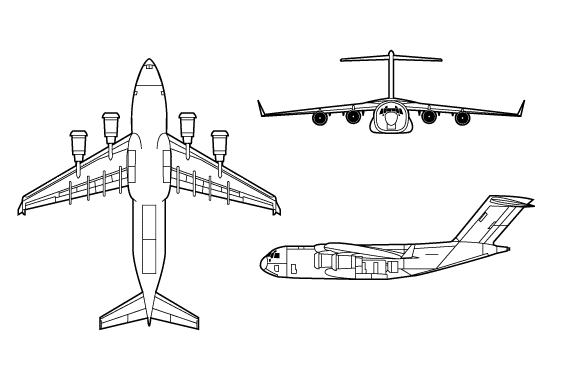
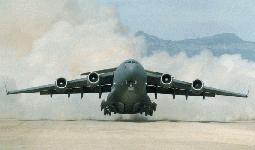
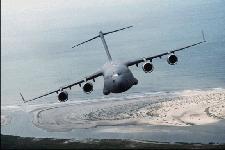
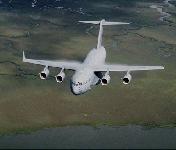
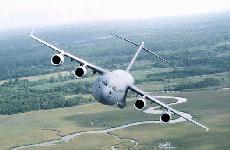
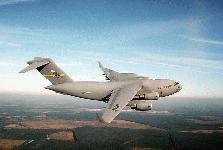
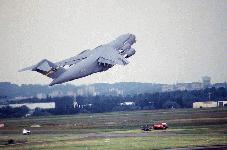
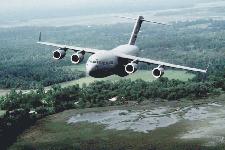
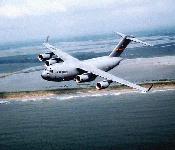
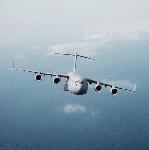
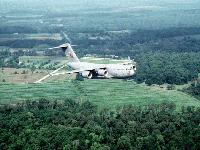
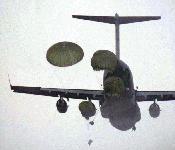
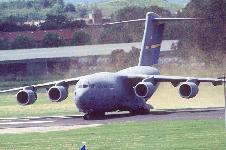
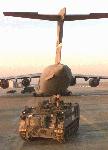
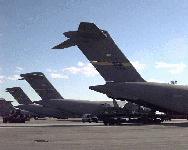
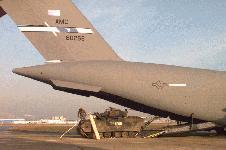
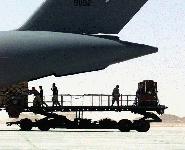
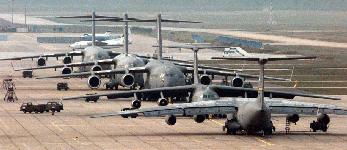
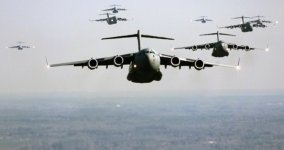
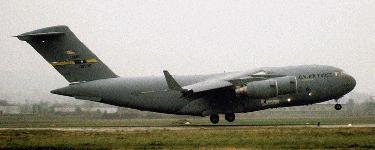
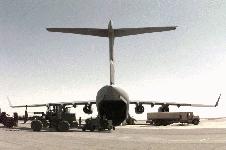
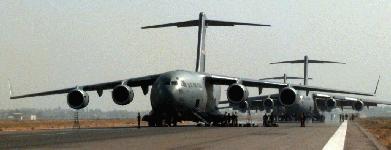
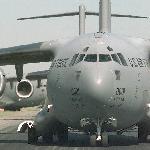
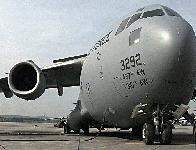
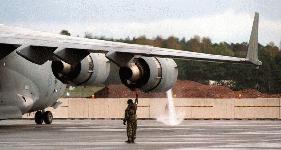
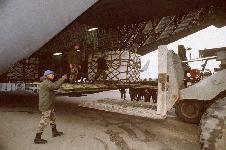
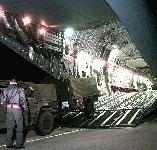
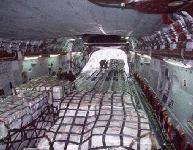
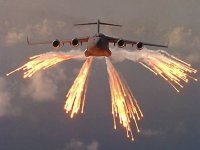
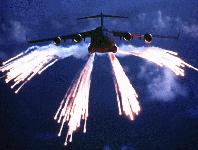
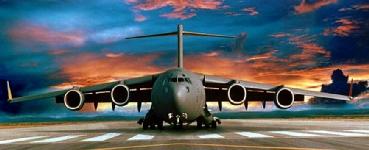




The C-17 is the newest airlift aircraft to enter the Air Force's inventory. The C-17 is capable of rapid strategic delivery of troops and all types of cargo to main operating bases or directly to forward bases in the deployment area. The aircraft is also able to perform theater airlift missions when required.
The C-17's system specifications impose a demanding set of reliability and maintainability requirements. These requirements include an aircraft mission completion success probability of 93 percent, only 18.6 aircraft maintenance manhours per flying hour, and full and partial mission capable rates of 74.7 and 82.5 percent respectively for a mature fleet with 100,000 flying hours.
The C-17 measures approximately 174 feet long with a 170-foot wingspan. The aircraft is powered by four fully reversible Pratt & Whitney F117-PW-100 engines (the commercial version is currently used on the Boeing 757). Each engine is rated at 40,900 pounds of thrust. The thrust reversers direct the flow of air upward and forward to avoid ingestion of dust and debris.
The aircraft is operated by a crew of three (pilot, copilot and loadmaster). Cargo is loaded onto the C-17 through a large aft door that accommodates military vehicles and palletized cargo. The C-17 can carry virtually all of the Army's air-transportable, outsized combat equipment. The C-17 is also able to airdrop paratroopers and cargo.
Maximum payload capacity of the C-17 is 170,900 pounds, and its maximum gross takeoff weight is 585,000 pounds. With a payload of 130,000 pounds and an initial cruise altitude of 28,000 feet, the C-17 has an unrefueled range of approximately 5,200 nautical miles. Its cruise speed is approximately 450 knots (.77 Mach).
The design of this aircraft lets it operate on small, austere airfields. The C-17 can take off and land on runways as short as 3,000 feet and as narrow as 90 feet wide. Even on such narrow runways, the C-17 can turn around by using its backing capability while performing a three-point star turn. Maximum use has been made of off-the-shelf and commercial equipment, including Air Force standardized avionics.
The C-17 made its maiden flight on Sept. 15, 1991. The aircraft is operated by the Air Mobility Command with initial operations at Charleston AFB, S.C., with the 437th Airlift Wing and the 315th Airlift Wing (Air Force Reserve). The C-17 program is managed by the Aeronautical Systems Center, Wright-Patterson AFB, Ohio.
C-17s played an integral role in Operation Enduring Force, moving troops, equipment, cargo, and humanitarian supplies around the theater. C-5s ferried enormous loads from the United States and other sources to allied bases in the region. The military then took advantage of the C-17's performance, especially its short runway takeoff capability, to deliver troops, equipment, and supplies as close as possible to the front lines.
The Large Aircraft Infrared Countermeasures (LAIRCM) program will upgrade C-17, C-130, and C-5 aircraft with enhanced infrared countermeasures to counter the threat from advanced IR-seeking missiles. It is expected that the LAIRCM program will leverage technology from the DIRCM system that protects Special Operations A/MC-130 aircraft to develop a laser-based system. The 418th Flight Test Squadron will oversee LAIRCM integration with C-17 and C-130 aircraft and conduct flight testing in the coming years.
Based on a buy of 120 aircraft, the last C-17 delivery will be in November, 2004. The original specification from McDonnell Douglas defined a service life of 30,000 hours. Modification programs will keep the aircraft in line with current and future requirements for threat avoidance, navigation, communications, and enhanced capabilities. These modifications should include global air traffic management (GATM) and automatic dependent surveillance to meet anticipated navigation requirements. Commercially available avionics and mission computer upgrades are being investigated to reduce life-cycle costs and improve performance. Also, upgraded communication systems to enhance worldwide voice and data (including secure) transmission will support command and control.
A two-year study of the defense transportation system by the USAF Mobility command concluded that the present transportation fleet will fall far short of future transportation requirements. The report, called Mobility Requirements Study-2005 (MRS-05), concluded that the minimum strategic airlift requirement was 54.5 million ton miles per day, though that figure may rise due to an increased demand on the airlift fleet after 9/11. Congress approved procurement of an additional 60 C-17s, to bring the total number of C-17s in the fleet to 120, but the USAF may need as many as 222 to satisfy future demand. These 60 follow-on aircraft will be delivered through FY 07, funded to maintain the current C-17 delivery of 15 aircraft per year.
Specifications |
|
| Primary Function | Cargo and troop transport |
| Prime Contractor | Boeing [McDonnell Douglas Corp.] |
| Power Plant Manufacturer | Four Pratt & Whitney F117-PW- 100 turbofan engines |
| Thrust (each engine) | 40,900 pounds |
| Wingspan | 170 feet 9 inches (to winglet tips) (51.81 meters) |
| Length | 173 feet 11 inches (53.04 meters) |
| Height | 55 feet 1 inch (16.79 meters) |
| Cargo Compartment |
Length - 85 feet 2 inches (26 meters); width - 18 feet (5.48 meters); height - 12 feet 4 inches (3.76 meters) forward of the wing and 13 feet 6 inches (4.11 meters) aft of the wing |
| Speed | 500 mph (Mach .77) |
| Service Ceiling | 45,000 feet at cruising speed (13,716 meters) |
| Range | Unlimited with in-flight refueling |
| Crew | Three (two pilots and one loadmaster) |
| Maximum Peacetime Takeoff Weight | 585,000 pounds (265,306 kilos) |
| Load |
102 troops/paratroops; 48 litter and 54 ambulatory patients and attendants; 170,900 pounds (76,644 kilos) of cargo (18 pallet positions) |
| Date Deployed | June 1993 |































